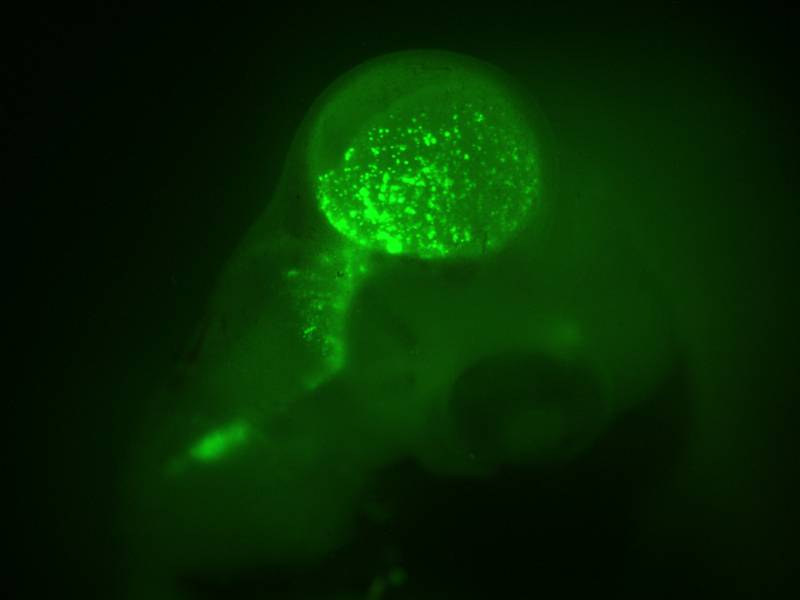Current projects
Research interests

midbrain electroporation
Where I came from: Before joining GVSU in 2008, I was a postdoc in Sean Morrison's lab at the U. of Michigan, and demonstrated that Rbpsuh, a transcriptional co-factor for Notch signaling pathway, was necessary for normal neural stem cell differentiation into glia in vivo. This work allowed me to integrate my expertise in protein chemistry during my PhD work (protein kinases and phosphoproteins) with cell signaling and neural cell biology.
Why GVSU is special: My lab’s research efforts have been shaped by the mission of my institution and what we love: training the next generation of scientists through excellent pedagogy in the classroom and pursuing pressing questions at the bench. My lab is staffed by undergraduate and masters level researchers (35% first generation college students; 85% of my students went on to attend graduate or professional school, all are employed in the biomedical field). Training affects the scope and speed of our progress, but the supportive environment here allows us to ask high-risk questions with an extended timeline. Further, we can leverage our discoveries to larger collaborative projects to solve important questions in biology (students love being a part of this scientific teamwork).
What we do: My lab works to determine how neural stem cells differentiate into specific cell types during development.
Recently we applied in ovo electroporation to identify that the bHLH gene Nato3 can promote dopamine (DA) neuron related genes in vivo, and that phosphorylation-mimicking modifications of this gene (dubbed “PM-Nato3”) can broaden the efficacy of Nato3 to drive these genes broadly in the CNS. The dopamine neuron relate genes that are upregulated include those that are important in DA neurogenesis .
Thus PM-Nato3 has the potential to make DA neurons for PD patients.
This work has led to a patent filing, support from the NIH, NSF, as well as the Michigan Economic Development Corporation to identify therapeutic and commercialization potential.
We currently have two main interests:
- The mechanism of Nato3 action on promoting expression of DA neuron related genes (Campbell Foundation supported work within our lab).
- Using PM-Nato3 to differentiate human embryonic stem cells into DA neurons (MEDC supported collaboration with University of Michigan’s human stem cell and genome editing core facility).
Currently seeking a part-time lab scientist position for this work! Please contact Merritt at [email protected].
My expertise in cell biology and protein chemistry are best illustrated in the following publications and patent filings:
Peterson, D., Jordan, S., Darcy, K., Elizabeth, K., Sarala, S., & DeLano-Taylor, M. (2019). The Basic Helix-Loop-Helix Gene Nato3 Drives Expression of Dopaminergic Neuron Transcription Factors in Neural Progenitors. Neuroscience, 2019 Nov; 421: 178-191 DOI: https://doi.org/10.1016/j.neuroscience.2019.09.003
Lindstow, C., DeLano-Taylor, M., Kordower, J., & Brundin, P. Does Developmental Variability in the Number of Midbrain Dopamine Neurons Affect Individual Risk for Sporadic Parkinson’s Disease? Journal of Parkinson's Disease 2020 10(2): 405-11. DOI:10.3233/JPD-191877
Taylor MK, Yeager K, Morrison SJ., Physiological Notch signaling promotes gliogenesis in the developing peripheral and central nervous systems. Development 2007 Jul; 134(13):2435-47 https://doi.org/10.1242/dev.005520
Taylor MK, Straight J, Peterson D, Huisingh N, Doyle D., Nato3 mutant polypeptides and uses thereof. Patent No. US20180346530A1 (awarded Sept 9, 2021). https://patents.google.com/patent/US20180346530A1/en
Taylor MK, Uhler MD., The amino-terminal cyclic nucleotide binding site of the type II cGMP-dependent protein kinase is essential for full cyclic nucleotide dependent activation. Journal of Biological Chemistry 2000 Sep 8;275(36):28053-62
